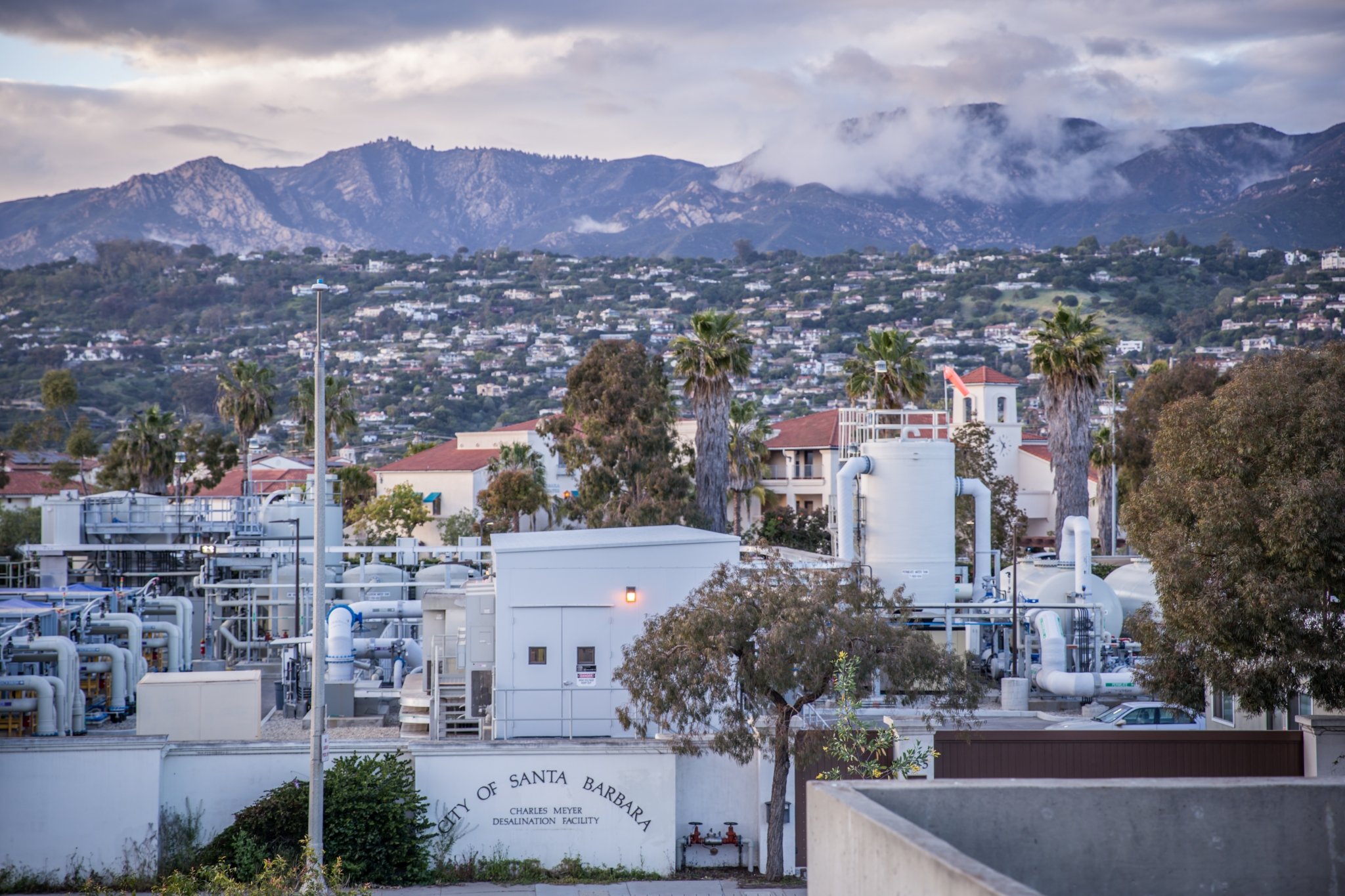How We Look at Desal: Updated
The Charles E. Meyer Desalination Plant in Santa Barbara, CA. Photo: Santa Barbara Independent
Evaluating the Potential Benefits and Downsides of Desalination
What are the specifics of modern desalination technology?
Modern desalination technology employs one of two approaches: multi-stage flash distillation or reverse osmosis. Flash distillation uses heat to evaporate seawater; the vapor, free from salt and other impurities, is then recondensed. Reverse osmosis removes water from salt through temperature differentials across a special membrane. Most modern desalination plants employ reverse osmosis.
What are the downsides of desalination?
Desalination requires a lot of energy: a major concern if fossil fuels are used to generate the necessary power, given the dire planet-warming effects of atmospheric carbon emissions.
There can be significant environmental impacts from desalination. Marine life can be adversely affected through the intake of seawater and the offshore discharge of concentrated brine, and the siting of desalination plants may degrade sensitive coastal habitats and wetlands.
Desalinated water is expensive. As noted in a 2019 peer-reviewed study by water resource researchers Heather Cooley and Peter Gleick, it is the most costly of commonly promoted water supply alternatives, including stormwater capture, recycling, and conservation. Desalinated water may or may not be as expensive as state and federal project water depending on annual availability and individual district contracts. It is generally much pricier than water from local sources.
What analysis should be conducted to determine whether desalination is an appropriate water supply investment?
First, communities must evaluate whether conservation measures, including indoor and outdoor use, business water use, and water system leak detection and repair, could cost-effectively reduce water shortage vulnerability. In many cases, conservation is a better option than additional water supply investments.
Second, desalination should be compared to other water supply options, including recycled water, stormwater capture, reduced agricultural use, and groundwater cleanup. Comprehensive comparisons should include impacts to rates and affordability, ability to contain operations & maintenance costs over time, and the efficacy of conservation during drought periods.
Third, there should be a full accounting of environmental impacts for all aspects of construction and operations. Environmental mitigation measures must also be built into economic analyses.
Is desalination appropriate in some situations?
If, after a complete analysis, desalination emerges as a viable option, it may be appropriate. For example, desalination may serve as an important drought buffer in certain coastal communities. For communities that are dependent on water imported from Northern California, desalination may, along with conservation and other local supplies, allow for reductions in imports that support environmental recovery in the San Francisco Bay-Delta estuary. Further, desalination plants should be owned and managed by the public; they should never be private, for-profit enterprises.
What are the features of “appropriate” and “inappropriate” desalination plants?
The Charles E. Meyer Desalination Plant in Santa Barbara (CEM) is a good model for desalination projects. Its daily output is limited to three million gallons, and it is only activated during extreme water shortages. Built in 1993, it was shut down after six months of operation following access to sufficient water from other sources. Major retrofits have been implemented at CEM since its construction. It now uses 40 percent less electricity than specified by its original design, and its intake pipes have been fitted with state-of-the art screens to minimize marine life impacts. The CEM physical footprint is small, and environmental impacts have been minimal.
In addition, CEM is publicly owned and managed, which helps control costs and ensure accountability. Desalination plants should never be privately owned, because private ownership contributes to higher costs and more pressure to produce desalinated water even when it is not needed. The Carlsbad desalination plant in San Diego County is a good example of the perils of private ownership. Since its inception, water rates for San Diego County residents have skyrocketed and local water systems must purchase (or pay for) the desalinated water even when less costly sources are available.
Another example of an inappropriate plant was the proposed and rejected Poseidon desalination plant at Huntington Beach. With a production capacity of 50 million gallons of drinking water daily, it was simply too large and its potential drawbacks too significant to warrant approval.
Poseidon Huntington Beach was hobbled by numerous problems:
It would have discharged 56 million gallons of concentrated brine daily to offshore waters.
The data on marine life impacts used by promoters were 17 years old and outdated.
The proposed site for the project likely would have flooded as sea levels rise from climate change.
Poseidon would have been privately-owned, meaning profit margins – not public welfare – would have determined its management and operation.
Customers for the plant’s desalinated water had not been confirmed.
The required energy may not have come from “green” sources.
The distribution pipe for the desalinated water would have run adjacent to a California superfund site, potentially releasing toxic chemicals into the community during construction and operations.
What specifications should any new desalination plants meet?
Intakes must be situated in wells below the ocean floor to protect marine life.
Outflow must be dispersed through extended perforated pipes to disseminate and dilute. concentrated brine over wide areas, preventing the creation of dead zones.
Plants must be owned and operated by public agencies – not private parties.
Desalination plants must only be operated as drought buffers, not as primary water sources. Therefore, their maximum output should be limited.
What about desalinating brackish groundwater?
Groundwater desalination has been proposed as an option for agriculture, particularly in the San Joaquin Valley. But a thorough quantification of groundwater – including brackish groundwater – should be completed before any such plans are implemented. Many of our groundwater basins already are overexploited, leading to land subsidence and aquifer contamination – and the problem is particularly acute in the San Joaquin Valley.

